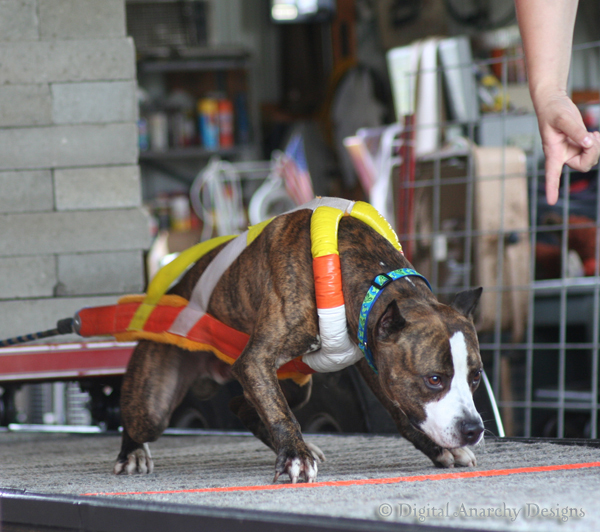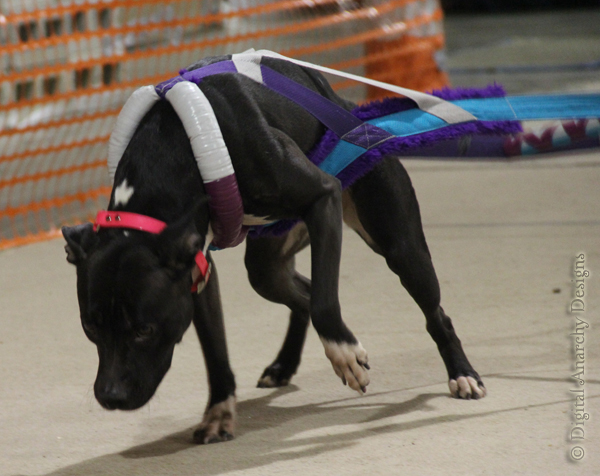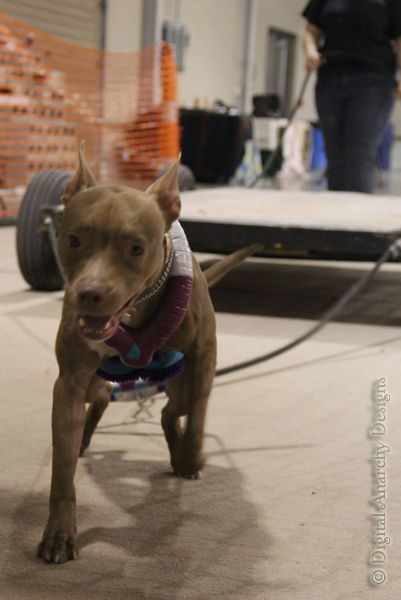
Ryker at the Pride & Prejudice UKC weight pull – July 2011
The sport of weight pull is an incredibly controversial sport amongst many dog owners. You have on one hand those that absolutely love the sport and the bond it creates with the dog and then on the other you have those who hate and/or fear the sport as a form of cruelty and abuse. Those same people feel that these dogs are being exploited for the purposes of human gain and the coercion of the dogs into performing on the track. This, however, couldn’t be farther from the truth for the majority of the weight pull community. (Yes, there are a few bad apples – in every sport. It’s just human nature.)
Once upon a time, I believed the same way those that are against it thought. I felt it was barbaric and cruel. I took the time, however, to go to a pull and found out how completely wrong I was. These dogs had absolute adoration for their handler/owner like dogs I’d seen paired and running agility or obedience routines.
From that moment on, I was hooked. I sucked up every little tidbit of information on training, conditioning, equipment and rules that I could get my hands on. I bought my first harness from Alaskan Dream Dog and had a go at weight pull. It was a very good harness for a new puller but as I became more experienced and talked to more people I realized I needed a harness upgrade and sank the money into one from Brown Dog Designs. It’s been madness ever since.

Lyric is starting to get the hang of weight pull.
The love for the sport is addicting. If you luck out and get a dog that absolutely loves to work (you know what I mean – the whole body wiggling, barking, prancing, etc. when they see that harness get pulled out…) you’ll never turn back and will probably catch the bug like so many of us that have been caught – hook, line and sinker.
That being said, not every dog is going to love weight pull. There are some dogs that absolutely loathe the concept of being constrained or digging in to get that cart the full sixteen feet down the track. If a dog doesn’t have that desire for this sport even the strongest bond isn’t going to make them work any harder or better no matter how persistent you are or how much you beg and grovel. What many people don’t realize is that if you push a dog that isn’t confident you can ruin them and shut them down completely.
I’ve seen it happen first hand unfortunately. Sadly, every single time it happened it was with an overzealous new handler who meant well but didn’t know any better. They do say you ruin your first dog but it doesn’t feel any better once you’ve realized you’ve done it. If you’re able to salvage what you’ve incorrectly done, it will be a slow go to repair the damage and get that dog’s innate ability into focus once more.
If you’re like me and go head over heels for this sport, I would suggest you attend a pull or two and pick the brains of all of the experienced weight pullers at the pull. The majority of people that attend these events are more than happy to talk to someone new and interested in the sport – even the highly competitive handlers. They know that at some point in time they too were in the same spot that the newbie they’re talking to is in right now.
Regardless of how your dog does, at the end of the day even if you don’t go home with the coveted Most Weight Pulled (MWP) or Most Weight Pulled per Pound (MWPP) trophy or ribbon you’ve still had a phenomenal day with your dog. You’ve worked together as a team. You cheered on new and old dogs while their handlers worked the same track and pulled the same weights you did – some just better than others.
Seeing the smile on the other handler’s faces and the ultimate love and adoration of their dog as they cross the finish line and the judge yells, “Pull!” is one of the most wonderful sights to behold. Most of us aren’t in it for the glory or the fame. They’re a nice additional bonus (as are those dust collectors that are stored in boxes waiting for us to move and have a wall of fame for our dogs) but they’re not the cream of the crop. Spending time with your fellow competitors, their dogs and your dogs means more in the end. It helps feed the desire to get back out there and do it all over again – just one more time…or maybe more than more time.

